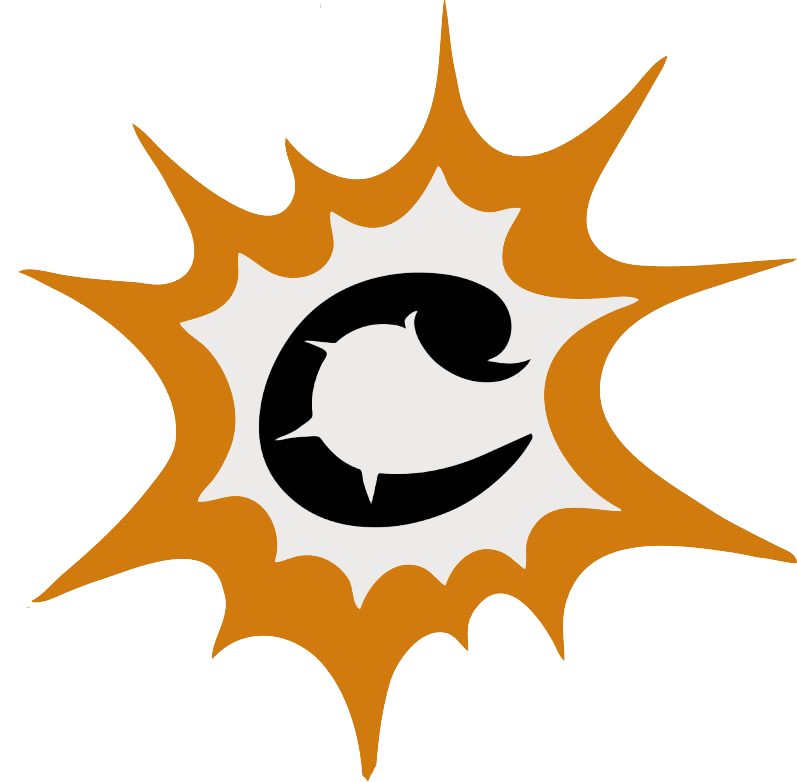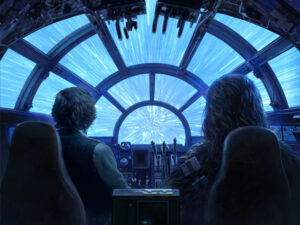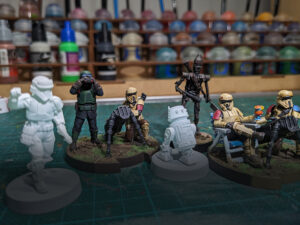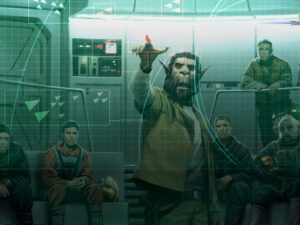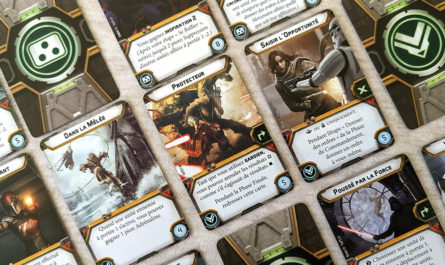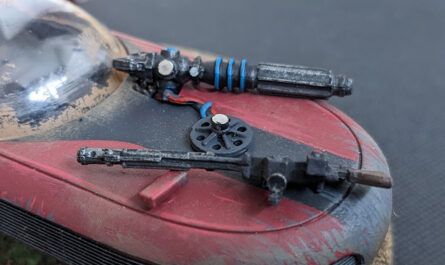You have chosen your faction and decided to play the Galactic Republic. So you’re pledging allegiance to democracy… until the day you enforce Order 66, right? Where should you start your Republic collection? Which units should you buy to build a competitive army? In this article, I’ll give you a roadmap of the essential purchases to field a Clone army in Star Wars: Legion.
What should you buy to start a Galactic Republic army?
The Galactic Republic Starter
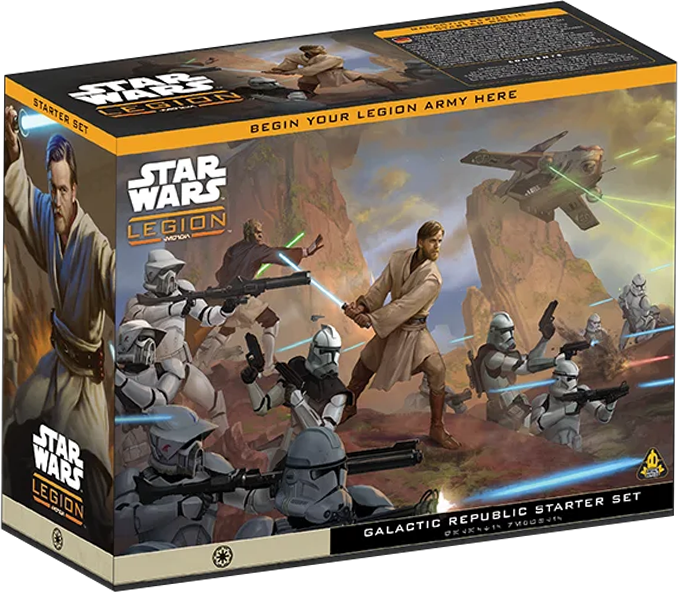
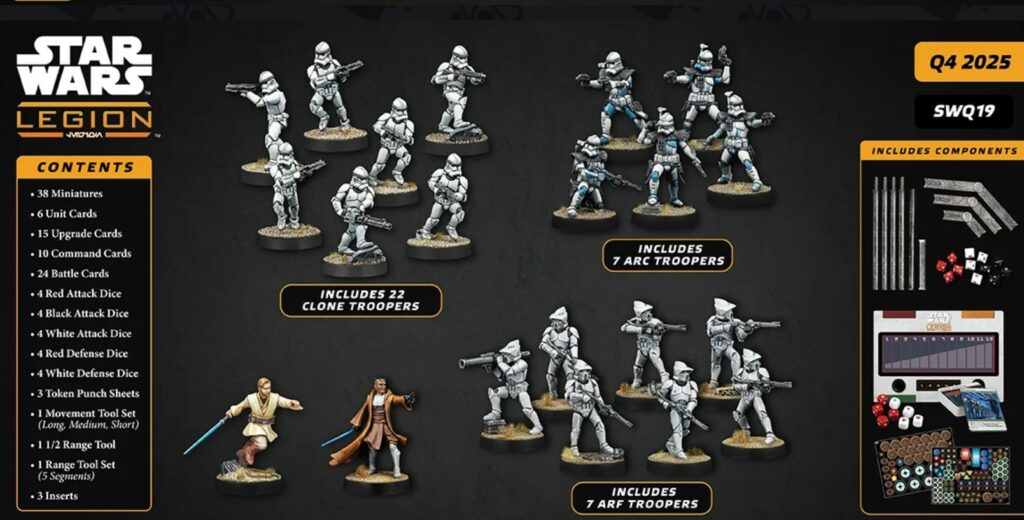
If you’re new to Star Wars: Legion, this starter set is by far the best entry point. It contains everything you need to play in the Skirmish format (600 points) while laying the foundation for a full Standard army (1000 points). The box includes 38 miniatures, making it easy to build a 600-point force:
- Obi-Wan Kenobi, enlightened warrior
- A Jedi Guardian
- 22 Clone Troopers
- 7 CRA Troopers
- 7 FRA Troopers
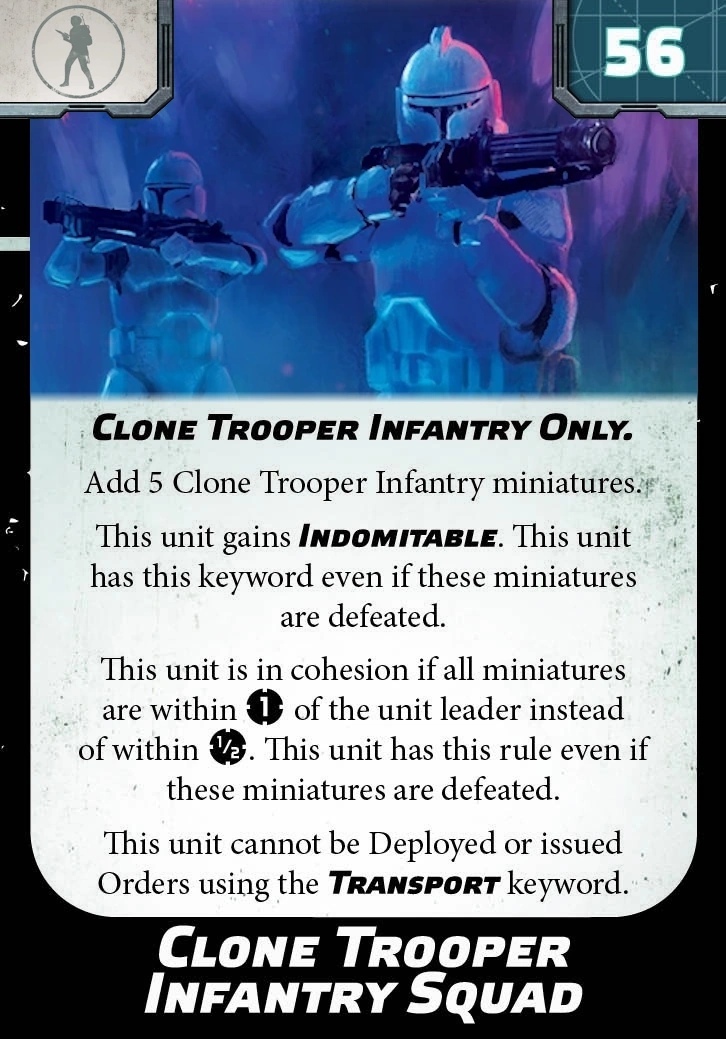
Note that Atomic Mass Games lists the number of miniatures, not the number of units. Why? Because your unit configurations determine how many figures you’ll need to build a unit. For example, a basic Clone Infantry squad is made up of 4 troopers. But upgrades like Squad can increase the unit size by adding 5 more soldiers. Based on my estimates, the starter lets you build between 6 and 9 units.
Thankfully, the box includes more than just miniatures—it also comes with the essential cards for your army to function properly:
- 7 unit cards
- 16 upgrade cards
- 10 command cards
- 24 battle cards
As well as the game components:
- 20 dice (4 of each type)
- Various tokens
- Movement tools (Long, Medium, Short)
- Range rulers
In short, the starter includes everything you need to play a Skirmish game, a format that requires a 600-point army on a 90 x 90 cm board. However, keep in mind that the Standard format is more popular, played on a 90 x 180 cm table with 1000-point armies. If you plan to attend tournaments, you’ll need to expand your collection with unit expansions.
Extra dice
As mentioned earlier, the starter only includes 4 of each type of die. To improve your playing experience, I recommend buying extra dice. This will save you from jotting down results on paper between rerolls. During a game, you’ll often need attack or defense pools of up to ten dice.
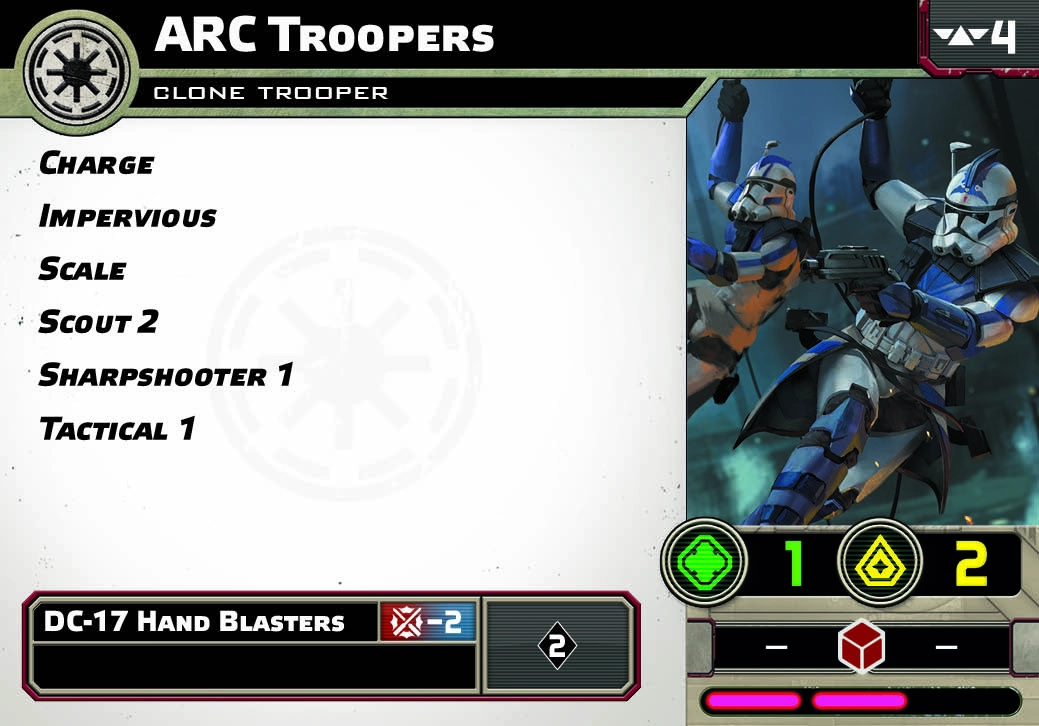
You can purchase extra dice in dedicated packs. Be aware that they are split into two different products: an Attack Dice Pack and a Defense Dice Pack.
Upgrade cards
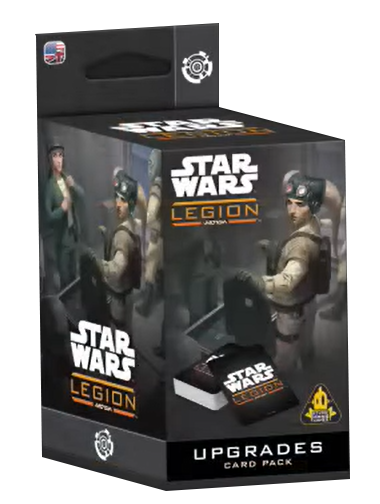
The upgrade card pack gives you a wide range of improvements for your units. These upgrades let you boost or specialize your troops. It’s a must-have product, but not an essential purchase: you can download the cards for free as print & play in English on the publisher’s official website;
Visually, these cards lack appeal. Unlike the previous edition of the game, Atomic Mass Games didn’t take the time to illustrate each upgrade. In my opinion, it’s not worth spending money on them—the print & play option is the better choice here.
.
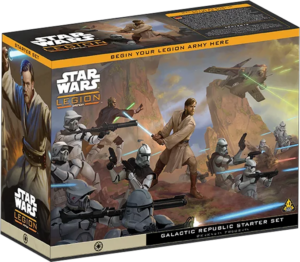
Deploy your first clones at an excellent price ✨
Which units should you buy after the starter?
If, after a few Skirmish games, you’ve fallen in love with the game, it’s green light to expand your collection and aim for the 1000-point format. You’re free to include any unit you like, and from here on your choices will lead to creative and unique combinations. Still, it might be wise to start with the following units:
Heroes
With your starter box, you’ll be sorely lacking in heroes. Sure, Obi-wan wields a lightsaber with grace, but if he falls in battle, all his command cards go with him. Better not put all your eggs in one basket. Fielding multiple heroes gives you greater resilience, more tactical flexibility, and a more intimidating presence on the battlefield…
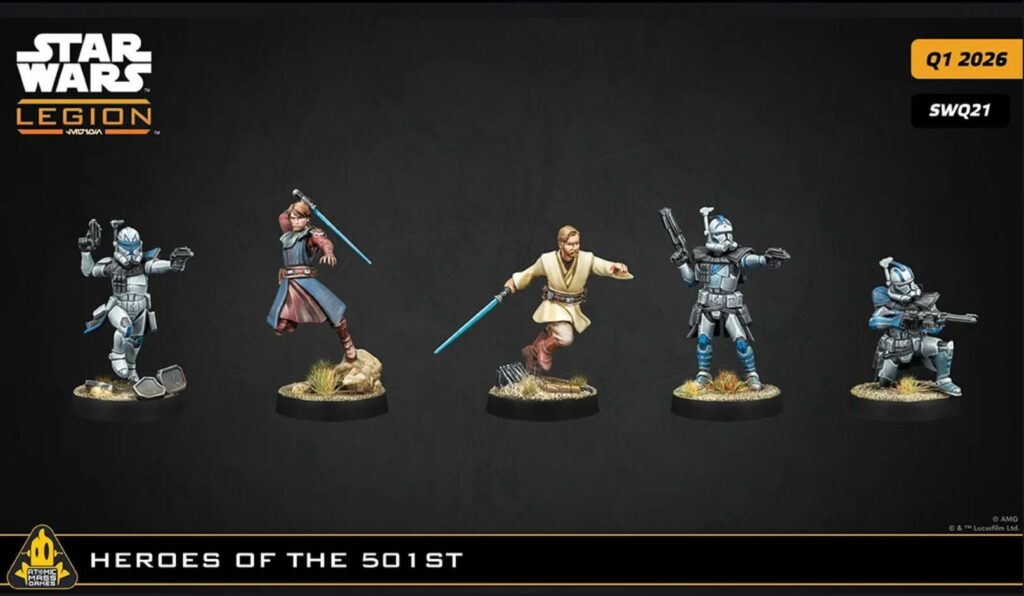
The heroes of the saga appear either as Commanders (e.g., Anakin Skywalker) or Operatives (e.g., Padmé). Regardless of their rank, each hero comes with around 3 command cards. Since a command hand is limited to 7 cards, you can include the full set of 2 heroes’ cards in your army list.
As for choosing your heroes, it really depends on your personal taste. Each hero has their own playstyle and synergies with certain units, which can help you structure the rest of your list. However, heroes don’t dictate your overall strategy in Star Wars: Legion. We’re far from what a commander represents in A Song of Ice and Fire, where they define the whole battle plan.
Examples
Obi-Wan Kenobi is a selfless and defensive commander. He dedicates himself to protecting allied units, as demonstrated by his keywords Guardian 3 and Soresu Mastery. These allow him to roll defense dice instead of nearby units targeted by attacks. Similarly, Obi-Wan’s command cards generate plenty of green tokens (like Dodge or Surge tokens — useful for defense).
In contrast, the droid R2-D2 is an operative who seeks to complete his own mission. His keyword Secret Mission allows him to score 1 victory point if he reaches the opponent’s deployment zone. He’s also excellent at repairing droid units or vehicles thanks to his keyword Repair 2: Capacity 2. That said, he can also create diversions when accompanied by his loyal friend C-3PO.
The best Republic units
Below, you’ll find the three most commonly played Republic units in competitive play as of 2025. Keep in mind that a wargame is a living game, meaning its rules evolve and unit profiles are regularly rebalanced. What is strong one year may not be the next.
Anakin Skywalker
For some players, Anakin is the best Force user in the game (i.e. including both Jedi and Sith). What sets him apart, beyond his powerful lightsaber attack (5 red dice, Impact 3, and Pierce 3), are his keywords Tempted and Djem So Mastery. The first allows him to counterattack a unit that just attacked an allied unit within range 3 of Anakin. The second lets him deal 1 damage to the attacking unit for each blank result in his defense roll. Add Charge and Deflect to the mix, and you’ve got a future Sith with incredible damage potential!
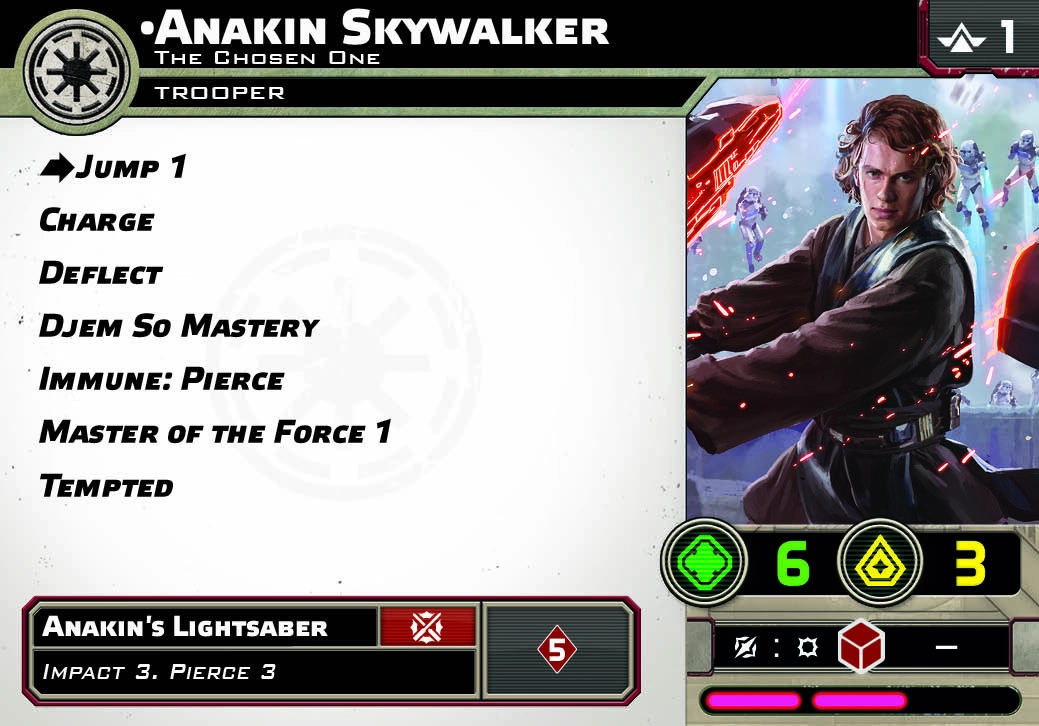
ARC Troopers
ARC Troopers are an auto-include for most Republic players. They benefit from excellent mobility thanks to their Scout 2 and Scale keywords, and that mobility is further rewarded by their ability to charge (move + free attack). On top of that, Ahsoka or Fives can join their unit.
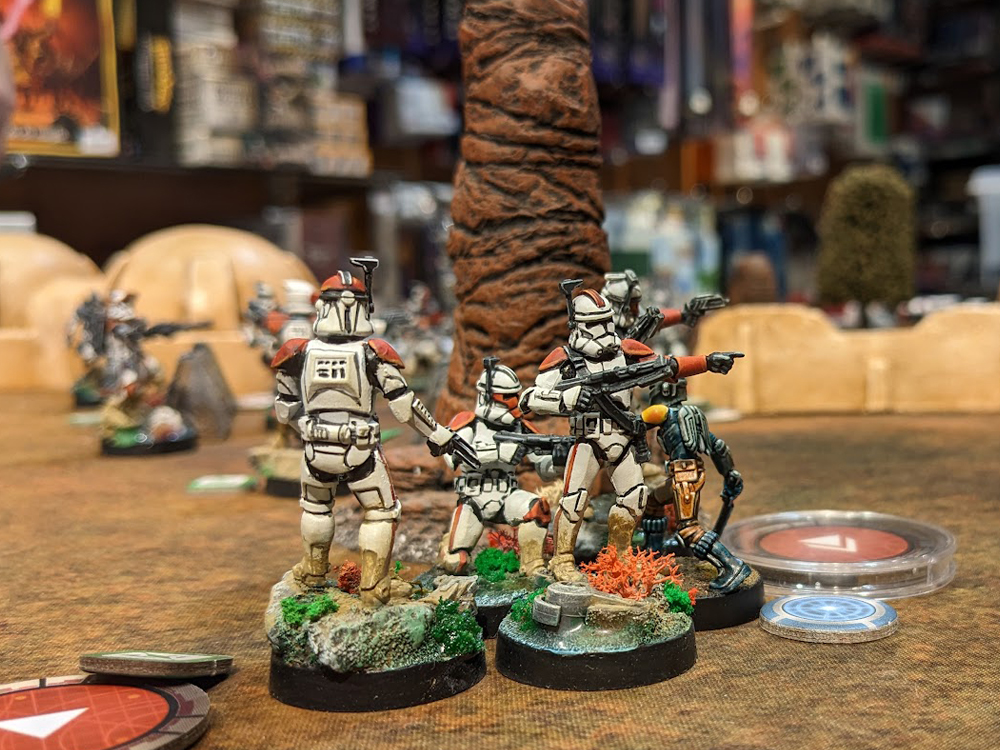
The Bad Batch
This squad of 5 to 6 warriors is not only one of the most resilient Republic units but also one of the deadliest. With 11 health points, red defense dice, and a whole array of keywords, the Bad Batch is a human tank.

Units in a Battle Force
A Battle Force is an alternative type of army list that comes with specific rules for army composition and gameplay. It represents a key moment (e.g., the defense of Kashyyyk) or a signature army from the saga (e.g., the 501st). In exchange, it imposes certain restrictions (like a limited selection of heroes) but can also offer more freedom in your army’s structure — for example, by lifting the usual limit on the number of Special Forces units. Battle Forces also typically include exclusive command cards usable only when playing that specific force.
Building toward a Battle Force is a good way to guide your purchases, as they focus on a limited pool of unit types. For example, the Wookiee Defenders Battle Force lets you recreate the Wookiee army that defended Kashyyyk in Revenge of the Sith. Since it’s almost entirely composed of Wookiees, your future purchases are pretty obvious: hairy beasts and more hairy beasts!
Is it worth buying older Star Wars: Legion products?
Star Wars: Legion was released in 2018 and has undergone several changes since. Initially published by Fantasy Flight Games (a branch of the Asmodee Group), the game was eventually transferred to another branch: Atomic Mass Games.
Upon acquiring Legion, AMG decided to reboot the game in 2025. So when browsing the web for Legion products, you may come across older references. Don’t worry: Republic miniatures from those boxes are still legal and can be added to your collection. However, there’s no longer any distinction between Phase I and Phase II Clones. Since version 2.6, both have the same profile, and helmet choice is now purely cosmetic. Also, heavy weapon minis from those old boxes can be used to complete an Elite Clone Trooper unit.
For more information on this topic, check out the dedicated article:
What to do if products are out of stock?
The availability of Star Wars: Legion products isn’t always guaranteed or consistent. If something’s out of stock, here are a few options:
- Check e-commerce websites in neighboring countries (Italy, Germany, the Netherlands, etc.) to try and find the missing product. Since Legion products are multilingual, there’s no issue with buying from abroad.
- Explore the second-hand market. Some Star Wars: Legion items can be found on Vinted. Remember that most older miniatures are still legal — it’s just their cards that are outdated.
- Create proxy miniatures and cards. Many talented sculptors sell 3D models on Gumroad, such as SkullForge or DarkFire Designs. As for cards, they can be downloaded for free from the official site.
Some tips to avoid regrettable purchases
Paint and play with your heart
One of the greatest joys in wargaming is building your own army—both in unit choices and visual style. Feeling pressured to buy miniatures just because they’re powerful, when they don’t appeal to you, is never a good idea. Painting them will feel like a chore, and they’ll likely take the place of units you actually love in your list. The risk? This hobby, instead of being a source of joy, could become a burden—and may even lead you to quit it altogether.
Try the game first and see how popular it is locally
Getting into a wargame is no small feat. It’s a time-consuming and potentially expensive hobby. So I recommend that you don’t dive headfirst into Legion, but test the waters first. Do you really like this game? To find out, try it:
- Either with a demo from a local player;
- Or through Tabletop Simulator;
- Or by starting with the bare minimum to play (see the first section of this article )
Then, check whether there’s an active player community in your area. It would be a shame to invest in lots of miniatures only to see them gather dust on a shelf.
Buying strong units is good. Understanding why they’re strong is better!
Fielding the best units doesn’t necessarily make for a good army list. It’s better to understand why a unit is considered strong: knowing its role and how it functions within your army helps you identify which other units best complement it. In short, if you understand how to build solid army lists, you’ll more easily identify what units you actually need. In the article below, I share 7 tips to help you build army lists on solid foundations:
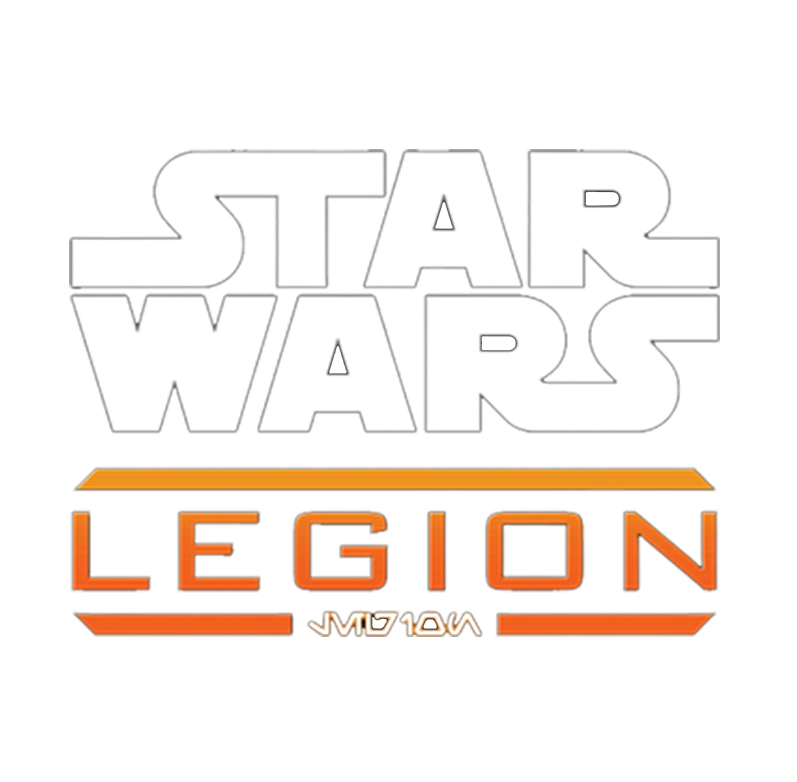
Find Star Wars: Legion players
Join your country’s SWL Discord community and connect with players nearby.
